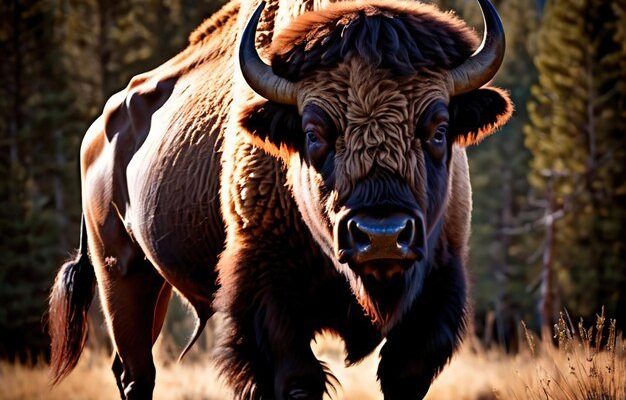
You might be wondering why such a big animal matters so much. Well, bison are more than just impressive due to their size (they can weigh up to 2,000 pounds!). They are a *keystone species*, which means they have a disproportionately large effect on their environment relative to their abundance. Let’s dive into how they influence everything from the soil to other wildlife in their habitat.
What Makes Bison a Keystone Species?
A keystone species is like a missing piece in a puzzle; without it, the whole picture doesn’t quite fit together. Bison help maintain the health of grasslands by grazing on various plants. This grazing ensures that no single species becomes too dominant, which can lead to a lack of biodiversity. Their grazing habits promote a mix of grasses and wildflowers, creating a rich environment for various animals.
Bison also play a crucial part in the nutrient cycle. When they graze, they not only remove the tops of plants but also allow sunlight to reach the ground. This sunlight helps new plants grow, enriching the soil. After they eat, their droppings provide essential nutrients back to the soil. Here’s the thing: without bison, these nutrients would be locked away in plant material instead of being recycled back into the ecosystem.
The Impact of Grazing on Plant Diversity
Let’s look deeper into how bison grazing affects plant diversity. Imagine a field where bison have been roaming. You’ll find a vibrant mix of grasses and flowering plants, all competing for space. Bison, with their unique grazing patterns, help keep that mix healthy. They typically graze on the more palatable plants first, which prevents any one species from taking over.
In areas without bison, you might see an explosion of certain types of grasses and a decline in wildflowers. This imbalance can hurt other wildlife that depends on those flowers for food or habitat. For instance, various insects, birds, and other animals rely on this diversity. By maintaining a balanced ecosystem, bison support not just plants but the entire food web.
Soil Health and Bison
Soil health is another critical aspect influenced by bison. Their heavy hooves turn the soil as they move, which can help break up compacted earth, allowing for better water infiltration. This process is essential during periods of drought, as it allows the soil to retain moisture more effectively.
Moreover, as bison trample on the ground, they create small depressions and disturbances that can become watering holes or small ponds during rain or melting snow. These water sources benefit countless other organisms, from tiny insects to larger mammals.
The nutrients in bison dung provide an additional boost to soil health. This dung acts like natural fertilizer, enriching the ground with essential minerals and promoting healthy plant growth. Honestly, if you think of bison as a gardener of the prairie, their role becomes clearer—they help cultivate a flourishing environment.
Bison and Their Relationship with Other Wildlife
Bison don’t just impact plants—they also have a significant effect on wildlife. For many species, bison create microhabitats. Birds often nest in the taller grasses that grow in bison-grazed areas, while smaller animals find shelter among the diverse plant life.
On top of that, bison also support predators in the food chain. Wolves, for example, may prey on bison calves. This predation keeps the bison population healthy by ensuring only the fittest individuals survive. A balanced predator-prey relationship is vital for any ecosystem, and without bison, this balance could be disrupted.
Even scavengers like ravens and eagles rely on bison, often feeding on the remains of bison that have died naturally. This scavenging is crucial for recycling nutrients back into the ecosystem. So, bison are not just important for plants; they create a ripple effect that supports a thriving community of wildlife.
The Importance of Bison in Climate Regulation
Believe it or not, bison also play a role in regulating the climate. By grazing and creating a diverse plant life, they help sequester carbon in the soil. Healthy grasslands can store significant amounts of carbon, which helps mitigate climate change.
In fact, preserving and restoring bison populations can be a natural way to combat climate issues. When you restore their original habitats, you’re not just saving a species; you’re also promoting a healthier planet for everyone. Isn’t it fascinating how one species can impact the entire Earth’s balance?
Challenges Faced by Bison Today
Despite their importance, bison faces several challenges. Habitat loss is a significant issue—their natural grasslands have been reduced due to agriculture and urban development. With less space to roam, bison populations struggle to maintain their numbers, which directly affects the ecosystems they help sustain.
Moreover, disease can impact bison herds, particularly when they are confined to smaller areas where they can easily spread infections. Conservation efforts are vital to ensure these magnificent creatures not only survive but thrive. Many organizations are working tirelessly to restore bison populations and their habitats. Their success benefits not only bison but also all species that depend on the grasslands.
The bison’s role in its ecosystem is nothing short of extraordinary. From maintaining plant diversity and enriching the soil to supporting wildlife and helping regulate the climate, their impact extends far and wide. Preserving this majestic animal and its habitat is crucial for maintaining the delicate balance of the grasslands they call home.
So, next time you think of bison, remember they are more than just a symbol of the wild West. They are *vital players* in the ecological drama of our planet. Protecting bison means protecting our natural world, ensuring a sustainable future for all living beings. Let’s celebrate and support these incredible creatures, recognizing their enduring legacy in the tapestry of life on Earth.

